One of the most emblematic timepieces of all time, the mythical Jaeger-LeCoultre Reverso endlessly renews itself in countless embodiments, even 90 years after its birth.
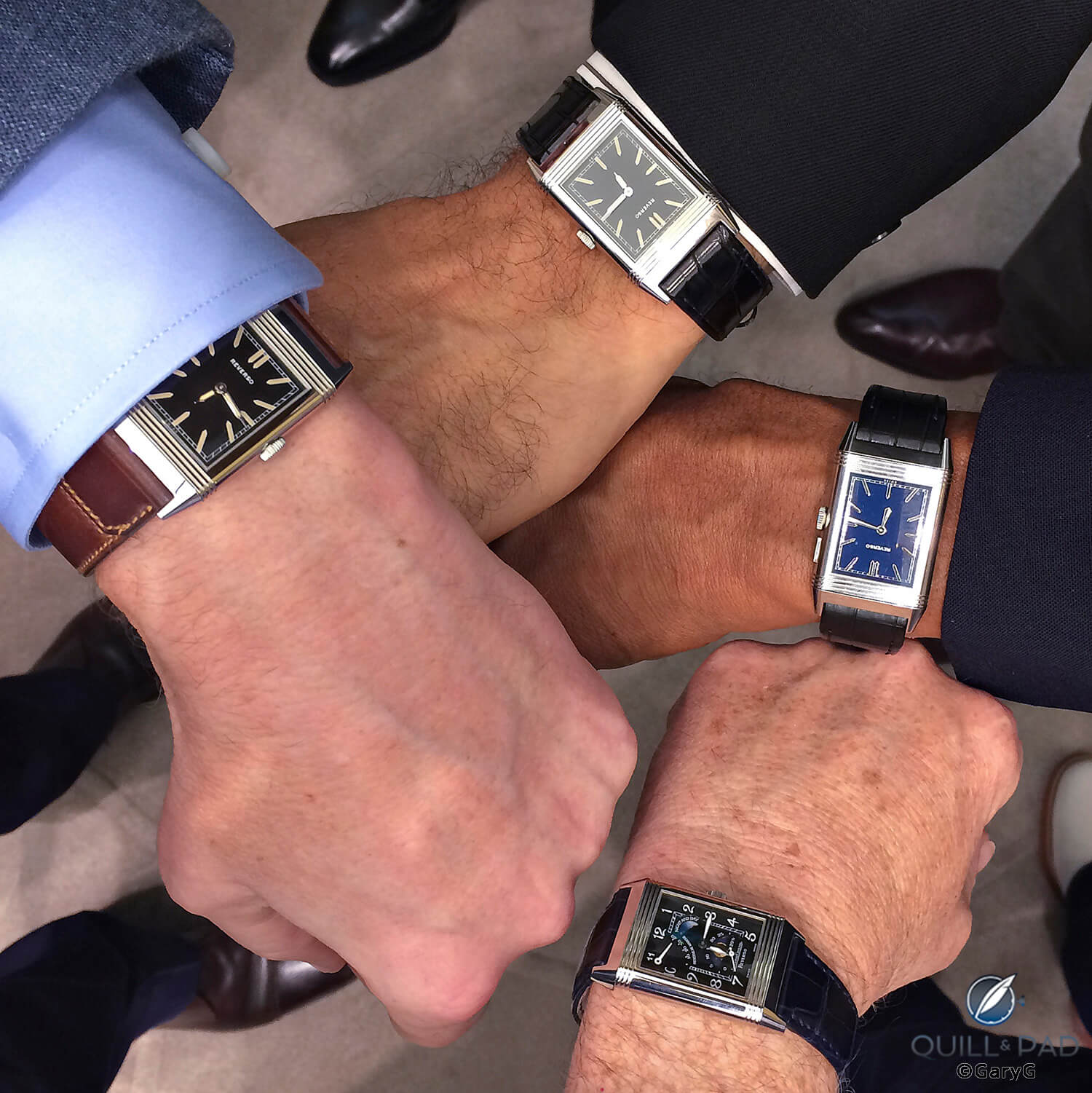
Jaeger-LeCoultre Reverso group wristshot
The Reverso’s origins stem from the beginning of the twentieth century when wristwatches were just becoming fashionable, even for sports. The idea behind its rectangular construction captures the modernity of the Art Deco period – which changed everything from art and architecture to music and fashion – and proposes aesthetically pleasing dimensions based on the golden ratio. It was first conceived in 1930 by César de Trey, a businessman distributing luxury Swiss watches worldwide, after a trip to India. One of his polo partners had smashed his watch in a game and challenged him to create a model that would survive a polo match unscathed.
Working together with Jacques-David LeCoultre, whose company LeCoultre & Cie was famous for its movements, and French engineer René-Alfred Chauvot, who came up with the ingenious case-pivoting system, the ultra-resistant Reverso in a stainless steel case was born a year later to the delight of polo-playing British army officers stationed in India.
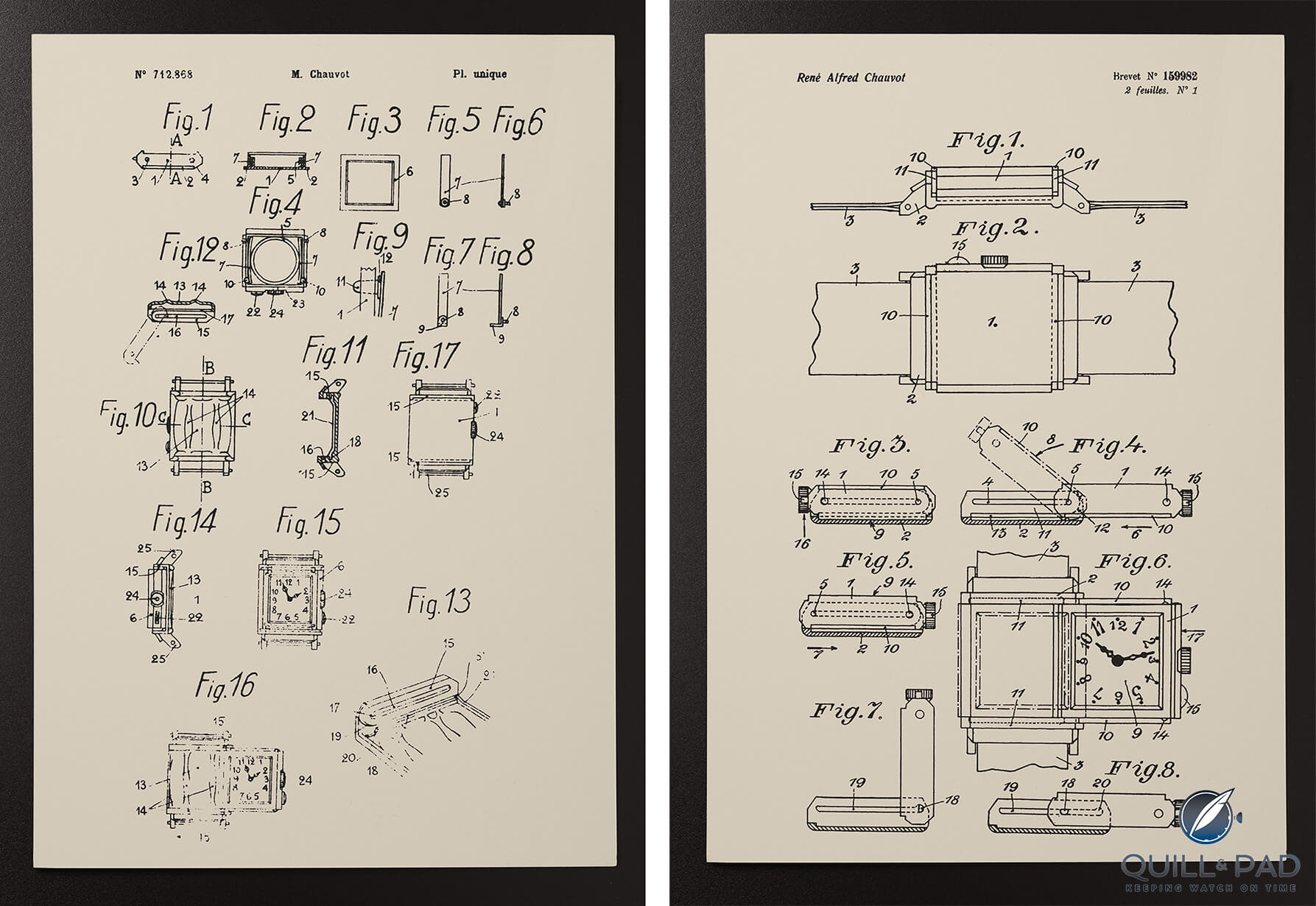
Original patent for the Jaeger-LeCoultre Reverso
The premise was simple: turn the case over to protect the watch crystal. With its characteristic and patented slide-and-swivel function and pure lines, the case, based on a mechanism of two spring-mounted spurs that slot into grooves on either side of the watch cradle, was a major breakthrough and the first of its kind.
Lionel Favre, product design director of Jaeger-LeCoultre, explains, “The Reverso’s eye-catching rectangular shape, uncluttered lines, and emblematic gadroons are all directly inspired by the Art Deco movement in vogue at the time of its creation. Its design is timeless and immediately recognizable.”
Soon after its launch, Jaeger-LeCoultre began to build movements to suit the contours of the reversible case with functions that best capitalized on the timepiece’s two faces.
90 years of emblematic Reverso models
Over the past nine decades, the Reverso has been powered by more than 50 separate calibers despite the extra challenges of rectangular-shaped movements as opposed to traditional round calibers.
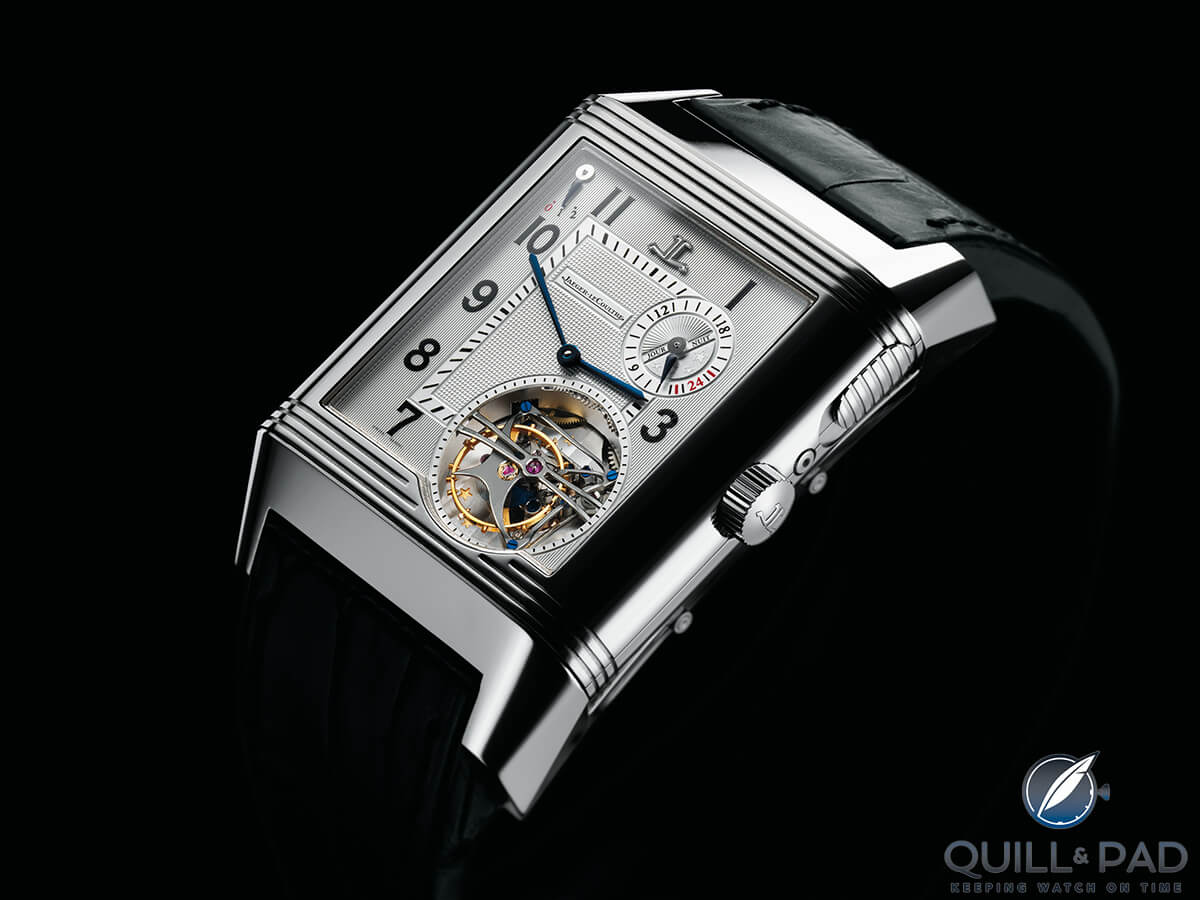
The front of the Jaeger-LeCoultre Reverso Grande Complication à Triptyque
On its sixtieth birthday in 1991, at the time of the renaissance of mechanical watchmaking following the so-called Quartz Crisis, the Reverso’s case became somewhat larger to be able to house more sophisticated complications, including the world’s first rectangular minute repeater, a retrograde chronograph, a perpetual calendar, the Grande Complication à Triptyque with 18 different functions, and the Gyrotourbillon with a biaxial flying tourbillon.
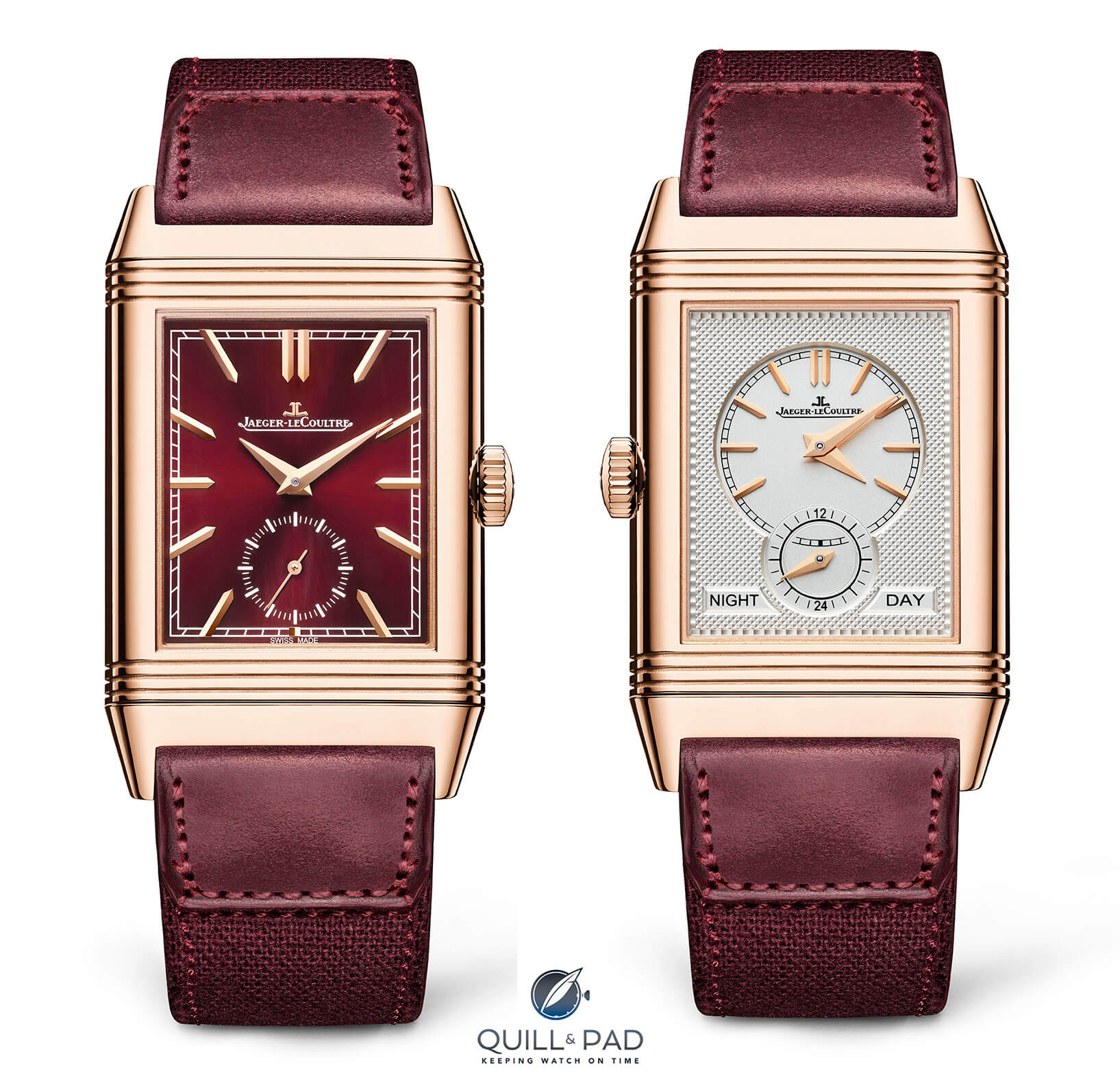
The two faces of the Jaeger-LeCoultre Reverso Tribute Duoface Fagliano
In 1994, the Duoface, the first Reverso to display a second time zone on the back dial, was introduced. The Duetto came along in 1997 with a dual personality animated by a single movement: a discreet and classic dial on the front and a more exuberant variant on the back.
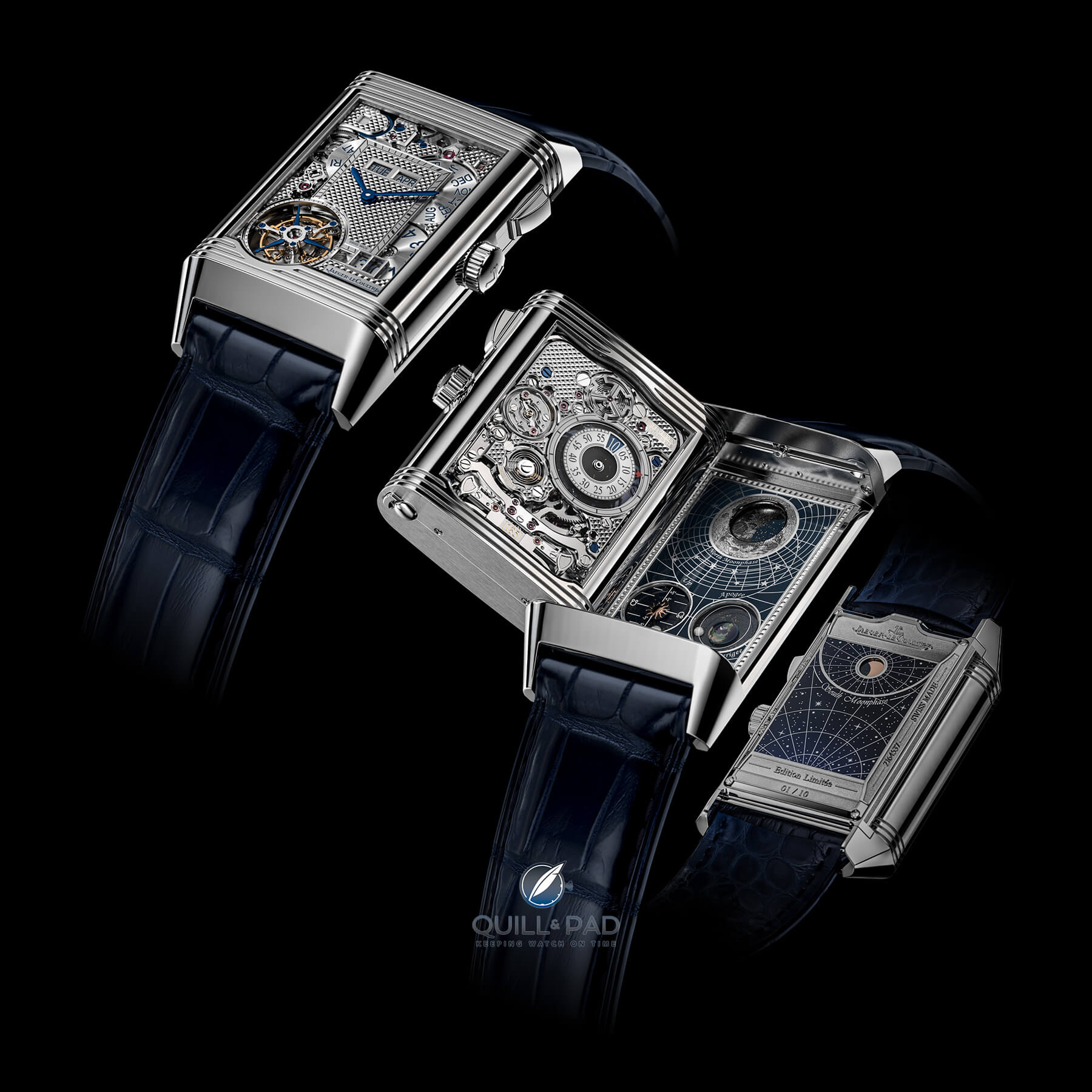
Jaeger-LeCoultre Reverso Hybris Mechanica Calibre 185 Quadryptique
Throughout the years, technical creativity has ensued, culminating in the exceptional Hybris Mechanica Caliber 185 Quadriptyque in 2021. The most complex Reverso ever made, it is highly legible and wearable despite its compactness. Six years in the making, it is the world’s first wristwatch with four functioning display faces and 11 complications, including a perpetual calendar, minute repeater, and innovative new astronomical indications predicting supermoons and eclipses, earning 12 patents along the way.
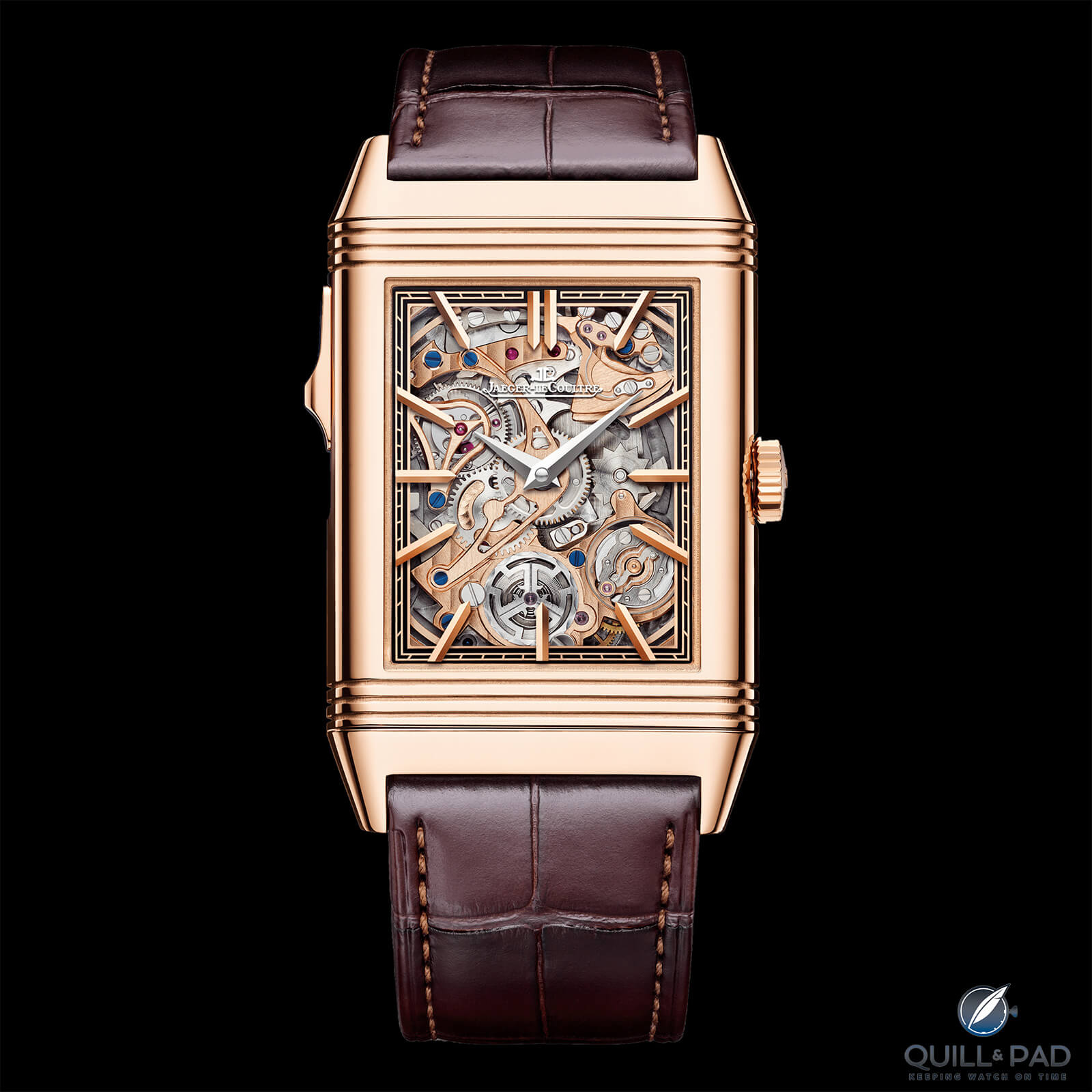
Jaeger-LeCoultre Reverso Tribute Minute Repeater
The latest Reverso is the dual-dial Reverso Tribute Minute Repeater powered by an upgraded version of in-house Caliber 944, which is equipped with technical advances such as Jaeger-LeCoultre’s patented trebuchet hammers, a silent regulator, and a new generation of gongs.
Unforeseen benefit of the Reverso swivel case
By creating the first reversible timepiece with a case made to protect the dial, exposing only the back to shocks, little did the designers know that their idea would play a role beyond that of a protective shield.
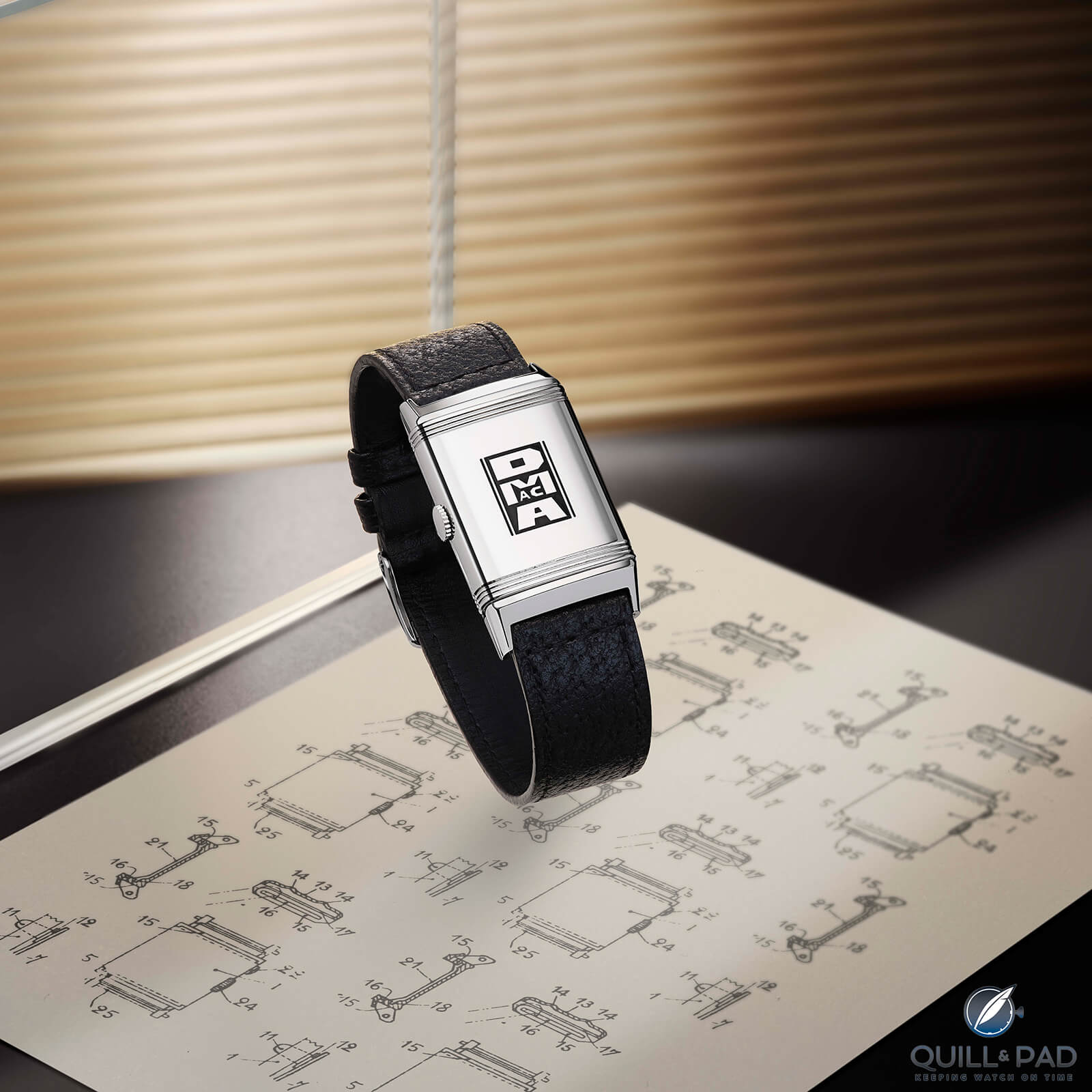
Jaeger-LeCoultre Reverso belonging to General Douglas MacArthur from 1940
Thanks to its blank metal flip side, the Reverso was also the perfect surface for celebrating artistic tradition, expressing emotions, and telling their owners’ stories. Great examples are the historic watches belonging to Amelia Earhart, the Maharajah of Karputala, and General Douglas MacArthur.
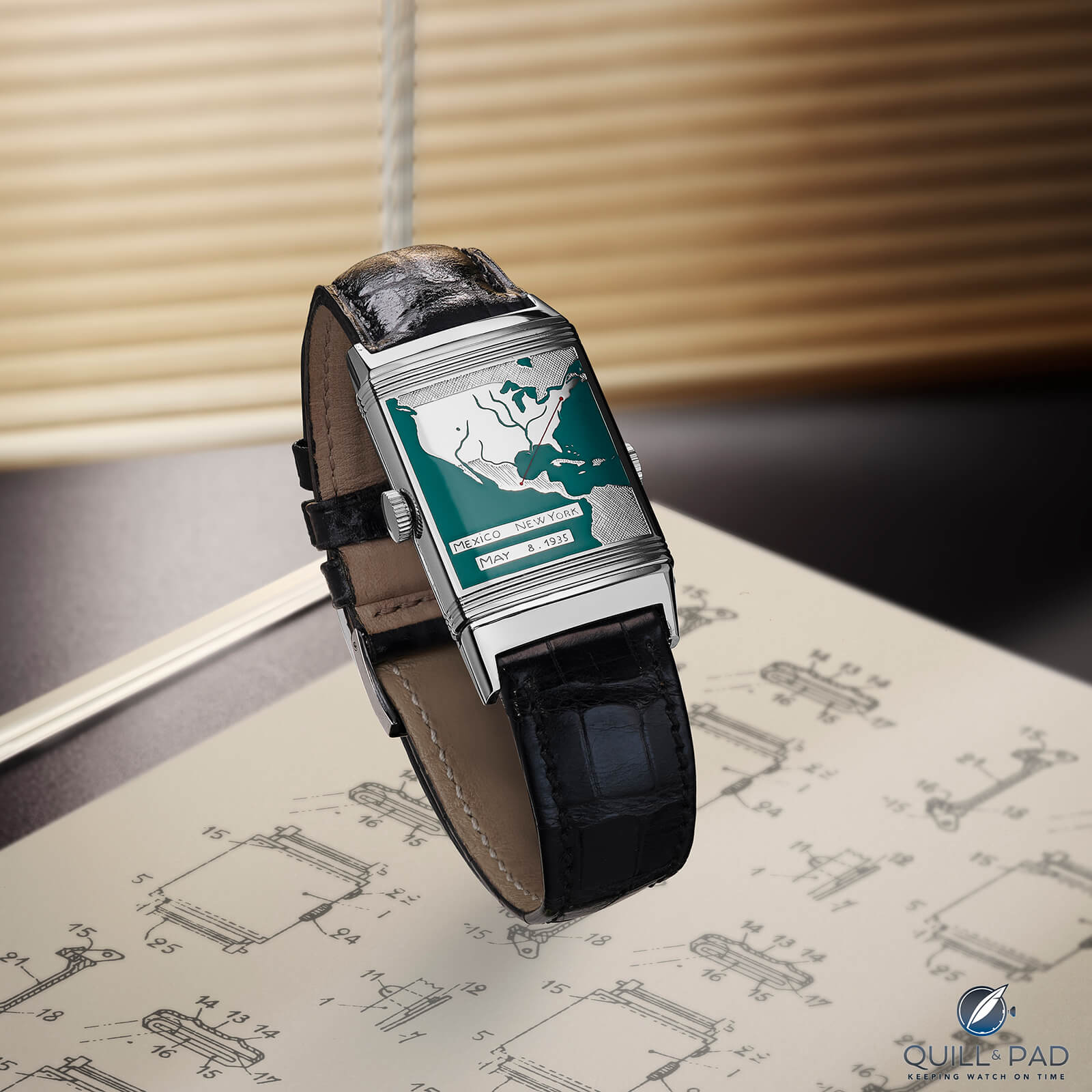
Jaeger-LeCoultre Reverso belonging to Amelia Earhart from 1935
Master artisans use hand-operated tools like dry-points, burins, gravers, chisels, files, and hammers to illustrate and personalize through crafts that include engraving, guilloché, gem-setting, miniature painting, and enameling carried out in-house. The second face of the swivel case can be decorated with coats of arms, initials, and drawings according to customers’ wishes.
In the middle of the twentieth century, as evolving tastes rejected ornamentation, these traditional artistic crafts started to disappear, but thanks to the revival of mechanical watchmaking in the 1990s, these techniques regained favor.
In 1996, the brand launched its first four timepieces adorned with grand feu enamel in modern times. Miklos Merczel, who set up Jaeger-LeCoultre’s own enameling studio, replicated works by Czech Art Nouveau master Alphonse Mucha in miniature.
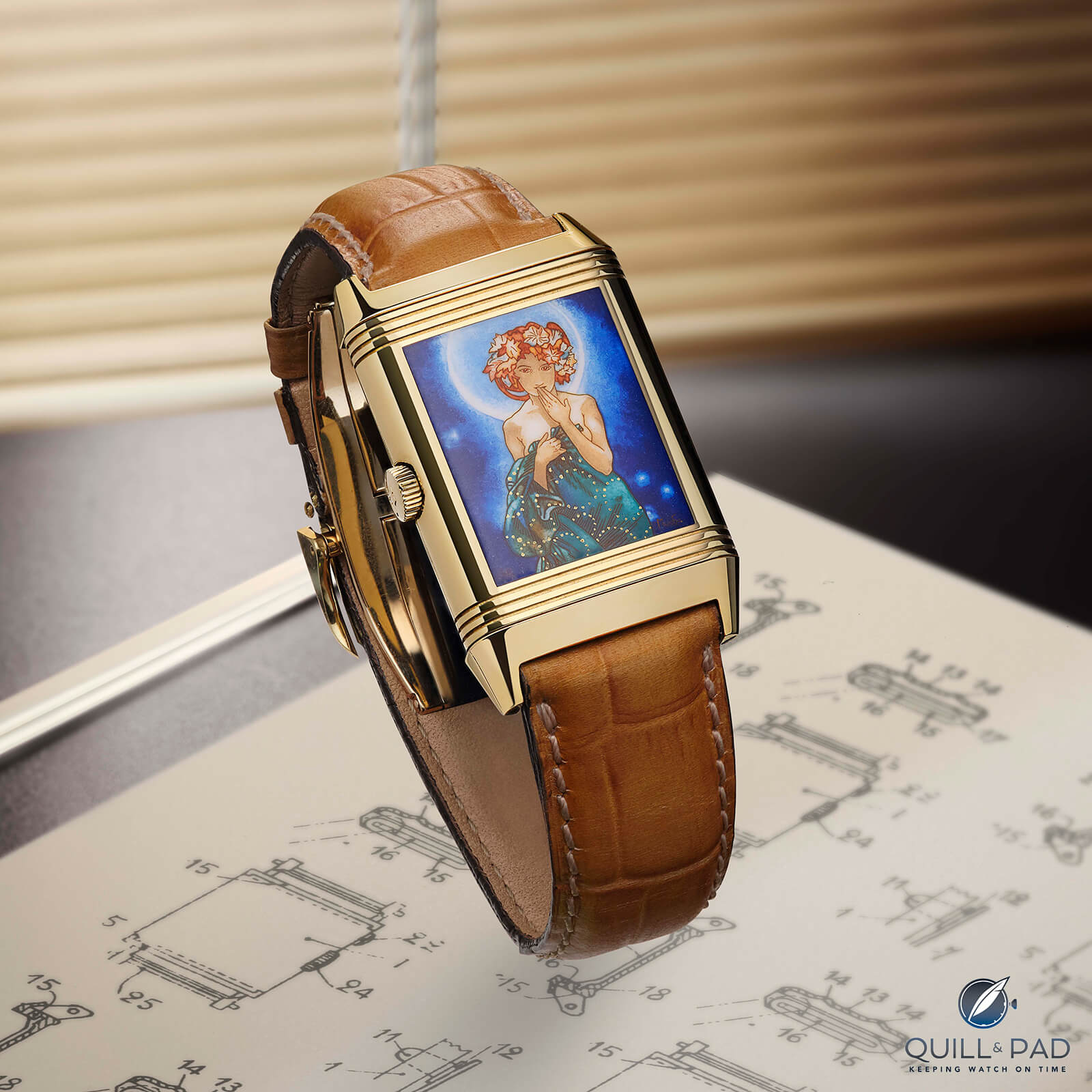
Jaeger-LeCoultre Reverso with an Alphonse Mucha miniature enamel painting by Miklos Merczel
In 2016, the Atelier des Métiers Rares was established, gathering enamelers, engravers, gem-setters, and guilloche craftspeople together under one roof. “While certain skills have been lost forever and others are no longer taught, Jaeger-LeCoultre is known precisely for its mastery of the highest fine watchmaking savoir-faire,” says Favre. “To produce and embellish its pieces, the ‘Grande Maison’ is one of the few fully integrated manufactures that unites no fewer than 180 skills under one roof.”
‘Reverso: Timeless Stories Since 1931’
To celebrate the icon’s ninetieth anniversary in 2021, the exhibition Reverso: Timeless Stories Since 1931 opened at the end of October and runs until December 24, 2021 at 15 rue du Faubourg Saint-Honoré in the 8th arrondissement of Paris. The exhibition takes visitors on a four-part voyage through time to discover the history of one of horology’s greatest legends.
Jaeger-LeCoultre ‘Reverso: Timeless Stories Since 1931’ exhibition
Catherine Rénier, CEO of Jaeger-LeCoultre, pronounced in her opening speech, “We invite you to join us on a journey – one that began in 1931. Born at the height of the Art Deco era, the Reverso watch has become a cult object over time, a symbol of style and elegance. May this be an unforgettable journey of discovery for you.”
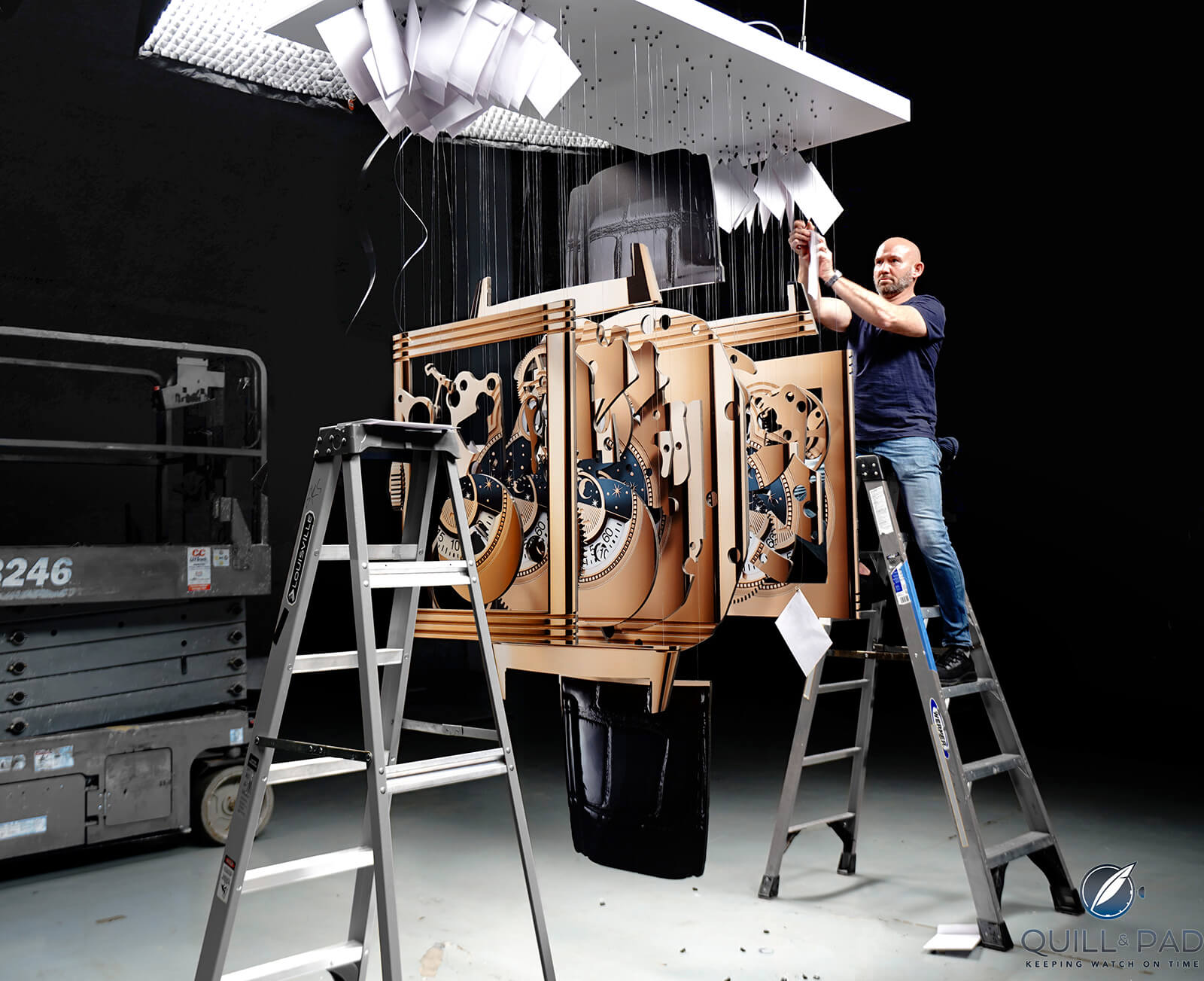
Jaeger-LeCoultre Reverso Tribute Nonantième installation by Michael Murphy
Displayed over five floors, the exhibition begins with the European debut of an installation by American artist Michael Murphy exploring space and time through a dive into the inner workings of the Reverso Tribute Nonantième, which features a moon phase and large date display on the front and semi-jumping digital hours, rotating minutes, and night/day indication on the back.
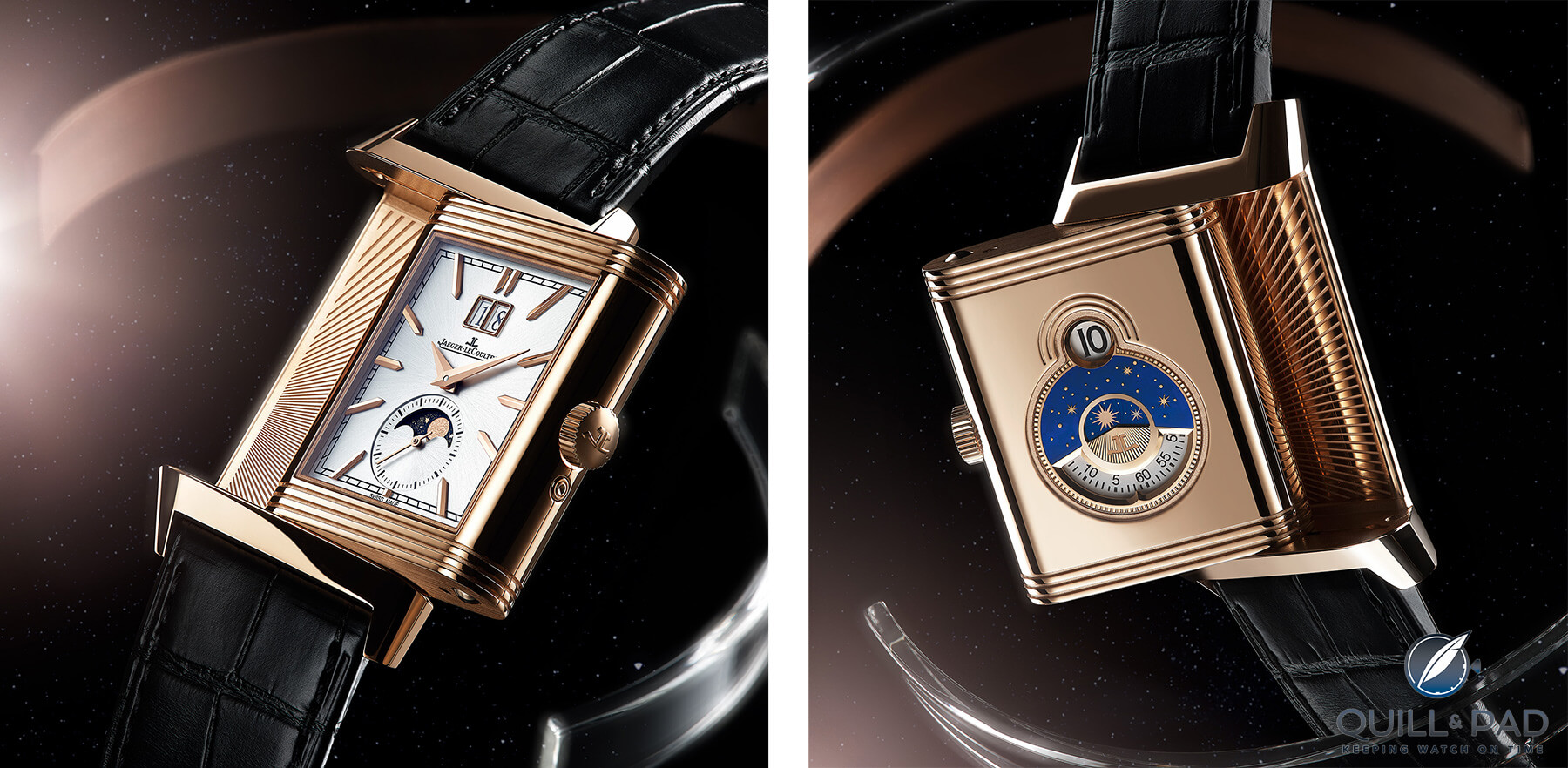
Jaeger-LeCoultre Reverso Tribute Nonantième front and back
We also find rare archival documents from the Jaeger-LeCoultre collection, vintage advertising posters, ébauches, watchmaking, engraving and enameling tools, the gold medal awarded to founder Antoine LeCoultre during the 1851 World’s Fair in London, and milestone Reverso timepieces including the first 1931 Reverso equipped with the Caliber 064, which arrived on the market less than nine months after the patent application for the reversible case had been filed.
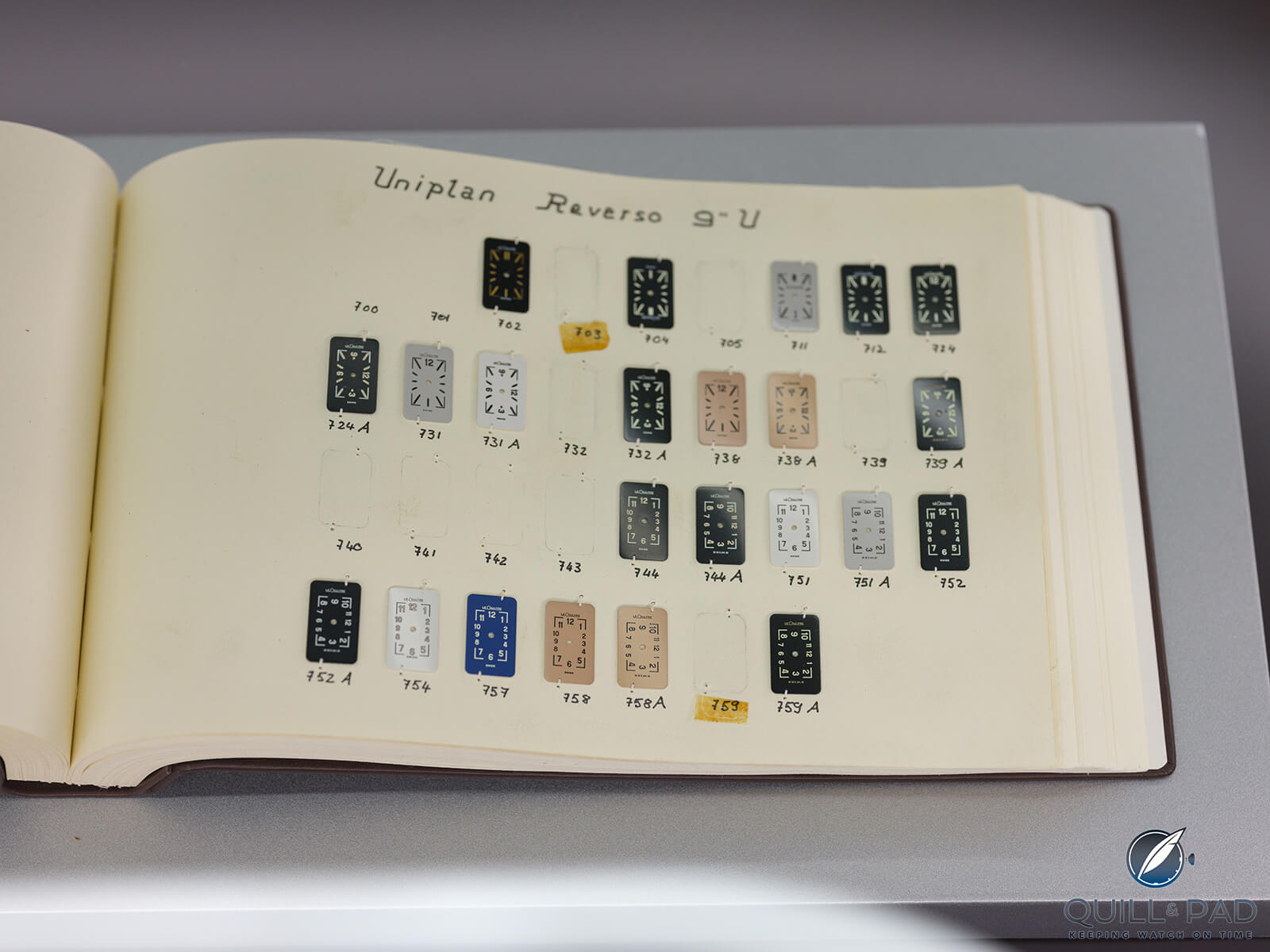
Historical Jaeger-LeCoultre Reverso dial options
While other brands proposed white or silver dials for their own reversible cases, the original Reverso watches broke with convention with their resolutely modern black dials adorned with contrasting, exceptionally legible indexes hailed as “the dial of the future,” which were immediately followed by made-to-order colored dials in bright red, chocolate brown, burgundy and even blue lacquer, rare at the time in watchmaking and today coveted by collectors.
From its origins, the elegance and comfort of wearing the Reverso also seduced non-sporty gentlemen, who adopted it rapidly as a dress watch; it has been available in both gold and steel since the first year of its creation.
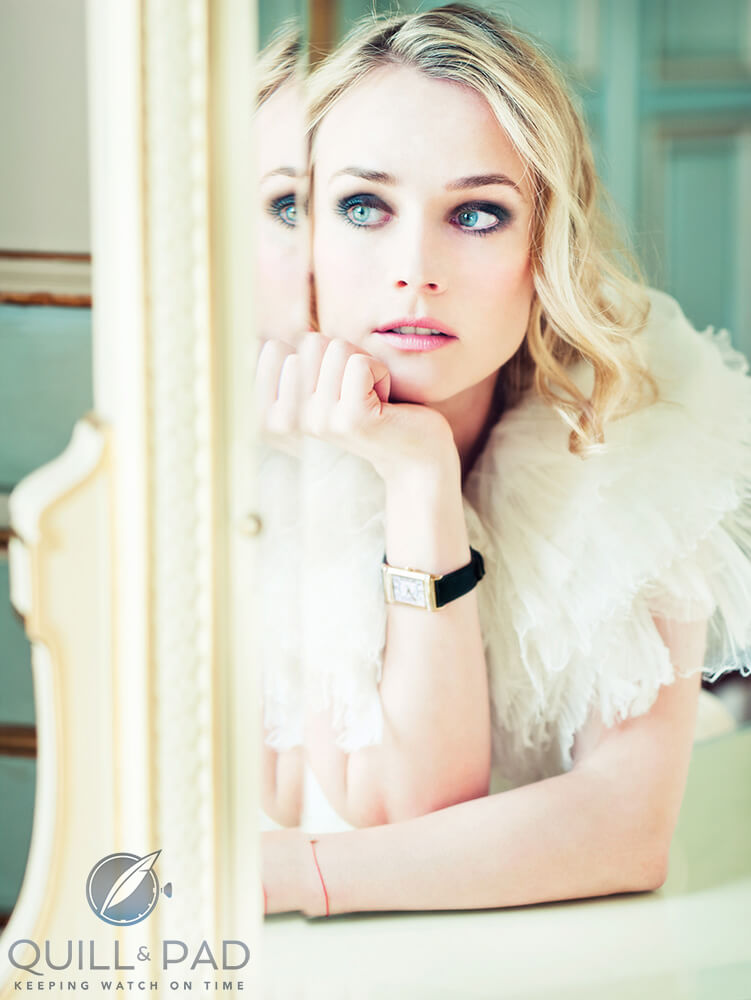
Diane Kruger wearing a Jaeger-LeCoultre Grande Reverso Lady Ultra Thin
Although initially conceived as a practical solution for polo players, the Reverso’s Art Deco lines also proved to be feminine from the outset, a rare example of a design that was equally suited to both men and women. Becoming a fashion accessory, different models offered women new ways of wearing the timepiece, such as on a finely woven cordonnet bracelet or as a pendant or a handbag attachment, while always retaining the core design elements.
The Reverso has also been at the heart of many firsts for Jaeger-LeCoultre. On display at the Paris exhibition is the Soixantième, the first complicated Reverso, launched in 1991 and featuring a central date hand and a power reserve indicator; included a sapphire crystal case back appearing for the first time in a Reverso.
Also exhibited are the 1993 Reverso Tourbillon, Jaeger-LeCoultre’s first tourbillon wristwatch; the 2001 Reverso Platinum No. 1 powered by the manufacture’s first skeletonized movement and featuring the first Reverso case in platinum; the extra-large 2002 Reverso Septantième with twin spring barrels, astonishing eight-day power reserve, and 28,800 vibrations per hour that marked a new benchmark in terms of precision; and 2021’s Reverso Tribute Small Seconds featuring a vintage-inspired green lacquer dial with matching leather strap, faceted hour markers, dauphine-style hands, and small seconds at 6 o’clock.
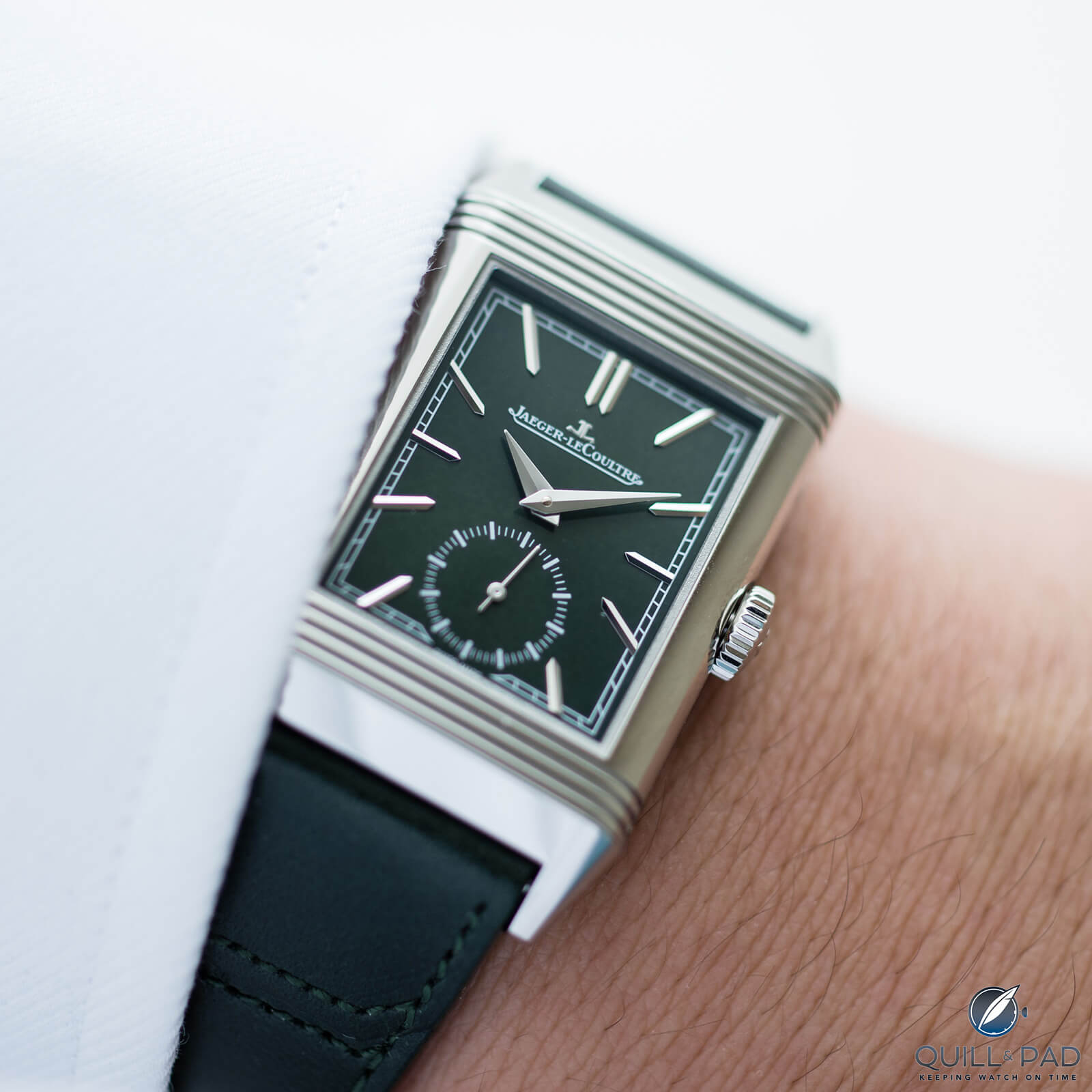
Jaeger-LeCoultre Reverso Tribute Small Seconds Green on the wrist (photo courtesy Peter Tung)
Showing off the potential of the Reverso’s metal case as an inexhaustible canvas for artistic expression that is constantly being reinvented by the maison’s artisans, visitors will also delight in a 1949 model bearing a painted portrait of Hindu King Rama commissioned by an Indian client, the 2006 Reverso à Eclipses with Félix Ziem’s depiction of nineteenth-century Constantinople on the dial side rather than the back, a 2016 high-jewelry version paved with aventurine and diamonds, and the new Reverso One Precious Flowers blending engraving, enameling, and gem-setting.
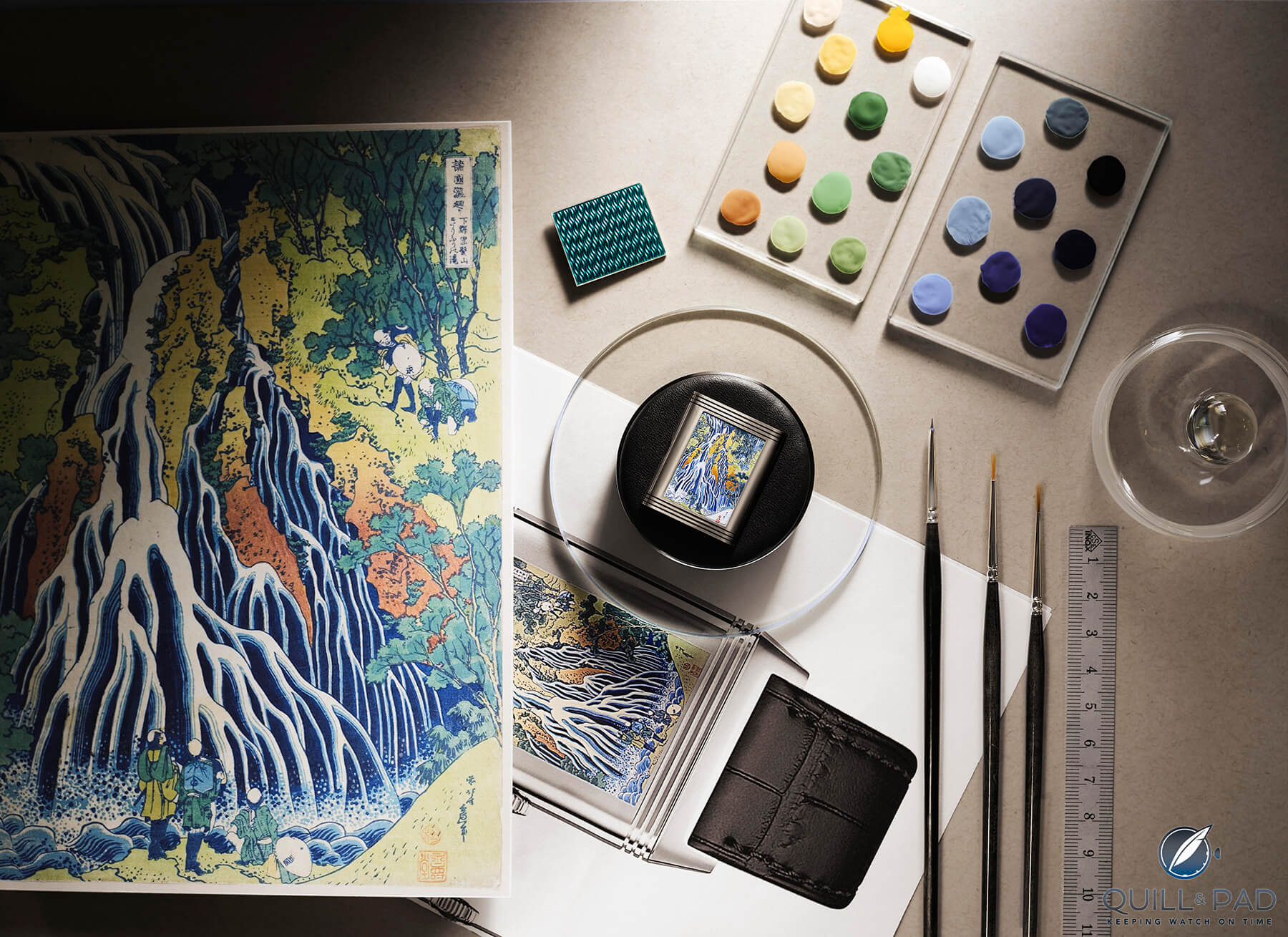
Jaeger-LeCoultre Reverso with Kirifuri Waterfall enamel miniature painting by Hokusai
As Jaeger-LeCoultre specializes in miniature reproductions of masterpiece paintings in enamel, the exhibition also displays Hokusai’s Kirifuri Waterfall, Gustave Courbet’s Vue du Lac Léman, Vincent van Gogh’s Sunset at Montmajour, and Gustav Klimt’s Portrait of a Lady. A craftsperson demonstrates how to apply perlage, and visitors can even try their hands at creating this decorative pearl pattern consisting of small circles applied to a metal surface.
A specially commissioned film takes viewers inside the Jaeger-LeCoultre manufacture to discover the creation of a Reverso through the words of the artisans and watchmakers themselves, accompanied by a pop-up boutique and a black-and-white Art Deco café on the top floor showcasing desserts by Parisian pastry chef Nina Métayer, which capture the scents and flavors of the Vallée de Joux, the birthplace of Jaeger-LeCoultre.
Rounding off the exhibition, the Atelier d’Antoine hands-on workshop – named after Antoine LeCoultre – has been relocated from the manufacture to Paris, offering horology enthusiasts and novices alike the opportunity to discover what goes into making a fine mechanical timepiece through interactive theoretical learning and practical training guided by a watchmaker and instructor.

Jaeger-LeCoultre Atelier d’Antoine Reverso Discovery Workshop
The Reverso Discovery Workshop delves into the inside story of the watchmaking icon, offering participants access to the Reverso archives, including original sketches and patent documents rarely shown to the public, and the opportunity to assemble a Reverso case comprising more than 50 components.
The next workshops (each 90 minutes long and priced at €150) will take place on November 12, 19, and 20 and December 10 and 11. The exhibition is free of charge to the public, and booking is recommended at www.exposition-reverso.com.
“The Reverso is an icon of style and elegance,” Favre concludes. “For nine decades, it has continually reinvented itself without ever compromising its identity. We hope it will continue to epitomize the spirit of modernity that inspired its creation now and in 90 years.”
Reverso: Timeless Stories Since 1931 runs until December 24, 2021 at 15 rue du Faubourg Saint-Honoré in the 8th arrondissement of Paris. Entrance to the exhibition is free.
For more information, please visit www.jaeger-lecoultre.com/eu/en/chronicles/exposition-reverso-paris.
You may also enjoy:
90 Years Of The Jaeger-LeCoultre Reverso
Why I Love The Jaeger-LeCoultre Reverso – And You Should Too
You Are There: Attending The Jaeger-LeCoultre Sound Maker Exhibition In New York City
Leave a Reply
Want to join the discussion?Feel free to contribute!





















































Good article. The Reverso is just perfect.